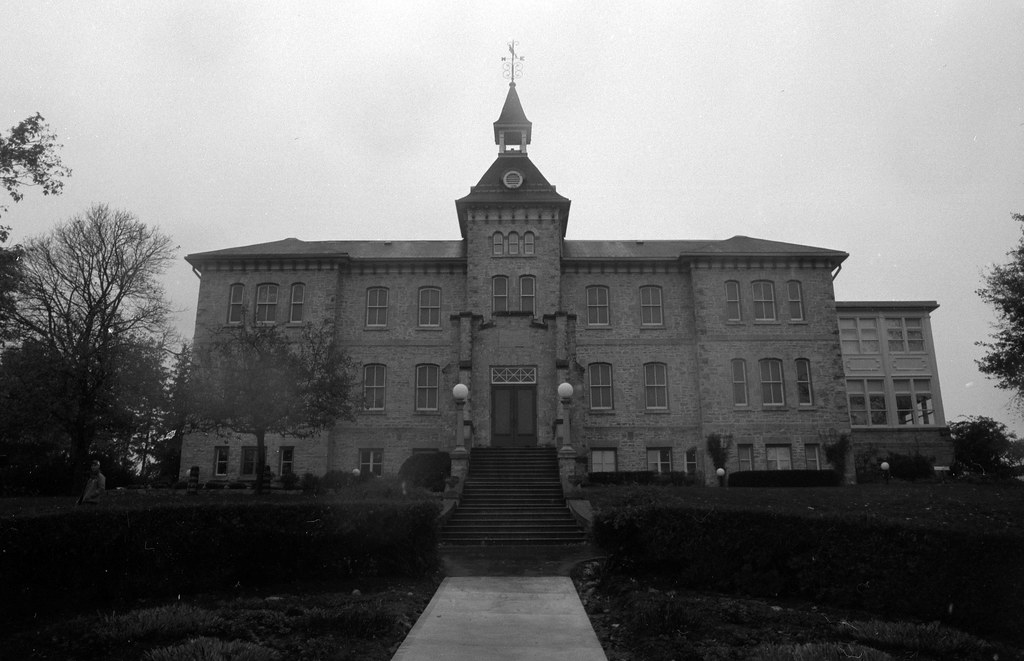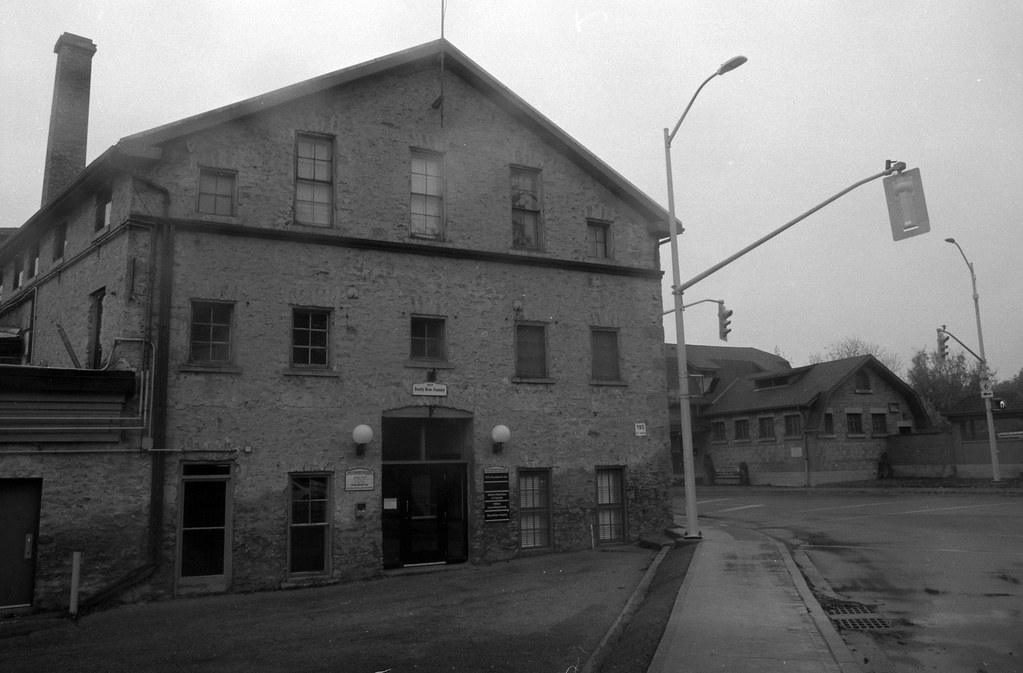I have seen Fergus in the past, but it’s only been for a short visit. Whenever I’m in this area, I tend to gravitate more towards Elora, Ontario, because it is a community that I enjoy exploring and can always find something new. But having already visited Elora this year and in this project, I needed someplace new. With the exact concentration of stone buildings from the 19th century and a walking route in mind, it was time to head into a bit of a pocket of the highlands in Ontario.

Nikon FM – AI Nikkor 28mm 1:3.5 – Fomapan 200 @ ASA-200 – Adox XT-3 (Stock) 6:00 @ 20C
For thousands of years before the arrival of the earliest European settlers, the Grand River has been home to a vast and diverse group of Indigenous people. Archaeological research shows the presence of human settlement by the Petun, Attiwonderonk, Anishinabewaki, Haudenosaunee and the Mississauga’s of the Credit. The area ceded under Treaty 4 would be marked for settlement by veterans of the War of 1812 in the 1820s as the Garafraxa Township. Richard Pierpoint of Senegal arrived in the United States as a slave and chose to fight for the British during the American Revolution to gain a release from slavery and later volunteered as part of the Coloured Corps during the Anglo-American War of 1812. After the war, Pierpoint began to petition for his promised land grant and, specifically, passage back to Senegal. However, the British authorities denied his requests instead of granting him and many other former soldiers of colour land in the Garafraxa Township. Pierpoint, having little choice, settled on Lot 6, Concession 1, near where Scotland Street is today. About a half-dozen former soldiers also settled in the region in 1822. These land grants carried several rules; the settlers were required to clear five acres of land, build a house and a road. If they did so within two years, the full title would be granted. The small group of farms became known as the Pierpoint Settlement. The Scottish would not arrive until a decade later, Adam Fergusson, a Scottish Lawyer and James Webster purchased a plot of 28 square kilometres. Fergusson, taken by the area and the available water power, began to survey a village site. Fergusson and Webster controlled those who could purchase the lots, with only those from Scotland or of Scottish descent being allowed. By 1835 a small settlement known as Little Falls had grown, with a sawmill, grist mill, several houses, a school and a church. Also, present a curling club (which still operates today). The establishment of a post office gave the name Fergus to the settlement after Adam Fergusson. By the middle of the century, the small settlement housed 184 with 21 businesses, and much of the black settlers were becoming the minority in the region as Fergus became mainly Scottish. The arrival of James Webster in 1855 brought a massive industrial base with an oatmeal mill, flour mill, and woollens mill, allowing incorporation as a village by 1858 and a population of 1000. The railroad, the Wellington, Grey & Bruce passed through in the 1870s bringing even more industry, notably the Beatty Brothers opening their foundry to build agricultural equipment. The Wellington County Poorhouse opened outside of the village in 1877, providing a place where those who were destitute, disabled or old could overcome their moral failing (pauperism was viewed in this manner) through hard work at the industrial farm to help support themselves and the staff. Credit Valley also ran through the village in the 1880s as part of their Elora branch. Fergus grew as a major manufacturing centre in the region. Still, it also became known for advanced medical technology, Dr Abraham Groves, noted for sterilisation of his surgical gear, performed the first appendectomy in 1883 and pushed for the installation of an electric generator in 1890. Dr Groves would help build a hospital in Fergus in 1902, today known as the Groves Memorial Hospital. The county poorhouse transformed itself into a nursing home in 1947 after many poor laws in Canada were abolished. While the community enjoyed a great deal of success and affluence through the mid-20th century, the industrial base would be unable to keep up with the times, and by the 1960s, many factories and mills were closing. In 1999 the community lost its autonomy and was absorbed into Centre Wellington along with the village of Elora. Today the historic town enjoys a lot of historical buildings from the 1800s, with even the old mills being adapted to modern uses.

Nikon FM – AI Nikkor 28mm 1:3.5 – Fomapan 200 @ ASA-200 – Adox XT-3 (Stock) 6:00 @ 20C
Nikon FM – AI Nikkor 28mm 1:3.5 – Fomapan 200 @ ASA-200 – Adox XT-3 (Stock) 6:00 @ 20C
Despite being surrounded by many impressive buildings, I found it easy to select the images for this week as I went for ideas that had some interesting stories behind them. As the Grand River remained the core of Fergus’ history, that shot turned into the featured image. From there, I went for buildings that showed some unique and historical aspects or stories. And the best part is that many still are in use, with only the Carnegie Library being in its original use. The old Beatty Foundry is now a marketplace, the original hydroelectric plant a pub & brewhouse. The Brew House on the Grand is where Heather and I had lunch while waiting for the rain to slacken. And finally, I had to include the beautiful Templin Gardens with Heather overlooking the raging river below. I wish I could have captured something related to the original settlers in the area, but nothing of the Pierpoint settlement remains memorialised.

Nikon FM – AI Nikkor 28mm 1:3.5 – Fomapan 200 @ ASA-200 – Adox XT-3 (Stock) 6:00 @ 20C
Nikon FM – AI Nikkor 28mm 1:3.5 – Fomapan 200 @ ASA-200 – Adox XT-3 (Stock) 6:00 @ 20C
Having a second camera (the Maxxum 9) with me, I wanted to keep things simple. Knowing I was dealing with a narrow street, I went with my old favourite, Nikkor 28mm f/3.5; we had some decent light, so I was getting apertures between f/4 and f/11 and shutter speeds of 1/125″. However, I shot the roll of film at the box speed of ASA-200 to give that extra boost of speed. For the developer, I went with something new: that new developer, Adox XT-3, which is based on the 2019 formula of Kodak Xtol. In contrast, I have used Xtol with Fomapan 200 in the past and was not too happy with the results. However, I think that had to do with an old and nearly expired batch of Xtol. This time around, the results impressed me! Excellent control of the grain, good sharpness and a bit of a bump in contrast, despite being in a foggy and low-contrast day.

Nikon FM – AI Nikkor 28mm 1:3.5 – Fomapan 200 @ ASA-200 – Adox XT-3 (Stock) 6:00 @ 20C
Nikon FM – AI Nikkor 28mm 1:3.5 – Fomapan 200 @ ASA-200 – Adox XT-3 (Stock) 6:00 @ 20C
Next week in Canada, we noted Remembrance Day, a solemn day to remember those who paid the ultimate sacrifice. I’ll be sharing some of the area’s cenotaphs and war graves for the fallen.